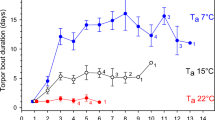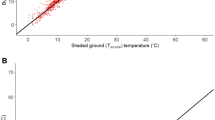Even in the wound-down hibernating state, this lemur can warm up without waking up.
Abstract
The Madagascan fat-tailed dwarf lemur, Cheirogaleus medius, hibernates in tree holes for seven months of the year, even though winter temperatures rise to over 30 °C. Here we show that this tropical primate relies on a flexible thermal response that depends on the properties of its tree hole: if the hole is poorly insulated, body temperature fluctuates widely, passively following the ambient temperature; if well insulated, body temperature stays fairly constant and the animal undergoes regular spells of arousal. Our findings indicate that arousals are determined by maximum body temperatures and that hypometabolism in hibernating animals is not necessarily coupled to a low body temperature.
This is a preview of subscription content, access via your institution
Access options
Subscribe to this journal
Receive 51 print issues and online access
$199.00 per year
only $3.90 per issue
Buy this article
- Purchase on Springer Link
- Instant access to full article PDF
Prices may be subject to local taxes which are calculated during checkout

Similar content being viewed by others
References
Arnold, W. et al. J. Therm. Biol. 16, 223–226 (1991).
Schmid, J. Int. J. Primatol. 19, 797–808 (1998).
Wang, L. C. H. Can. J. Zool. 57, 149–155 (1979).
Heldmaier, G., Ortmann, S. & Körtner, G. in Life in the Cold: Ecological, Physiological and Molecular Mechanisms (eds Carey, C. et al.) 175–183 (Westview, Boulder, Colorado, 1993).
Humphries, M. M., Thomas, D. W. & Kramer, D. L. Physiol. Biochem. Zool. 76, 165–179 (2003).
Carey, H. V., Andrews, M. T. & Martin, S. L. Physiol. Rev. 83, 1153–1181 (2003).
Author information
Authors and Affiliations
Corresponding author
Ethics declarations
Competing interests
The authors declare no competing financial interests.
Supplementary information
Supplementary Methods
This supplement gives information on the study site and the experimental procedure of the study (trapping, temperature measurements, radio-tracking, number of study animals, data analysis). (DOC 32 kb)
Rights and permissions
About this article
Cite this article
Dausmann, K., Glos, J., Ganzhorn, J. et al. Hibernation in a tropical primate. Nature 429, 825–826 (2004). https://doi.org/10.1038/429825a
Issue Date:
DOI: https://doi.org/10.1038/429825a
This article is cited by
-
A multi-tissue gene expression dataset for hibernating brown bears
BMC Genomic Data (2023)
-
Hypometabolism with the speed of ultrasound
Nature Metabolism (2023)
-
Terrestrial Tree Hugging in a Primarily Arboreal Lemur (Propithecus verreauxi): a Cool Way to Deal with Heat?
International Journal of Primatology (2023)
-
The biology of beauty sleep
Nature Ecology & Evolution (2022)
-
Atypical for northern ungulates, energy metabolism is lowest during summer in female wild boars (Sus scrofa)
Scientific Reports (2021)
Comments
By submitting a comment you agree to abide by our Terms and Community Guidelines. If you find something abusive or that does not comply with our terms or guidelines please flag it as inappropriate.



